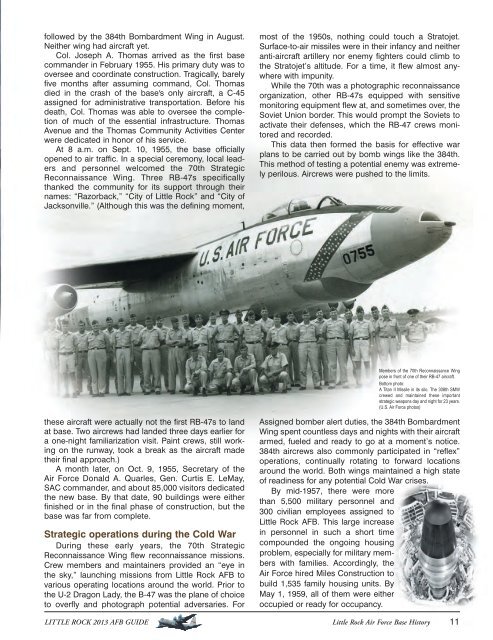Little - Keep Trees
Little - Keep Trees
Little - Keep Trees
You also want an ePaper? Increase the reach of your titles
YUMPU automatically turns print PDFs into web optimized ePapers that Google loves.
followed by the 384th Bombardment Wing in August.<br />
Neither wing had aircraft yet.<br />
Col. Joseph A. Thomas arrived as the first base<br />
commander in February 1955. His primary duty was to<br />
oversee and coordinate construction. Tragically, barely<br />
five months after assuming command, Col. Thomas<br />
died in the crash of the base's only aircraft, a C-45<br />
assigned for administrative transportation. Before his<br />
death, Col. Thomas was able to oversee the completion<br />
of much of the essential infrastructure. Thomas<br />
Avenue and the Thomas Community Activities Center<br />
were dedicated in honor of his service.<br />
At 8 a.m. on Sept. 10, 1955, the base officially<br />
opened to air traffic. In a special ceremony, local leaders<br />
and personnel welcomed the 70th Strategic<br />
Reconnaissance Wing. Three RB-47s specifically<br />
thanked the community for its support through their<br />
names: “Razorback,” “City of <strong>Little</strong> Rock” and “City of<br />
Jacksonville.” (Although this was the defining moment,<br />
these aircraft were actually not the first RB-47s to land<br />
at base. Two aircrews had landed three days earlier for<br />
a one-night familiarization visit. Paint crews, still working<br />
on the runway, took a break as the aircraft made<br />
their final approach.)<br />
A month later, on Oct. 9, 1955, Secretary of the<br />
Air Force Donald A. Quarles, Gen. Curtis E. LeMay,<br />
SAC commander, and about 85,000 visitors dedicated<br />
the new base. By that date, 90 buildings were either<br />
finished or in the final phase of construction, but the<br />
base was far from complete.<br />
Strategic operations during the Cold War<br />
During these early years, the 70th Strategic<br />
Reconnaissance Wing flew reconnaissance missions.<br />
Crew members and maintainers provided an “eye in<br />
the sky,” launching missions from <strong>Little</strong> Rock AFB to<br />
various operating locations around the world. Prior to<br />
the U-2 Dragon Lady, the B-47 was the plane of choice<br />
to overfly and photograph potential adversaries. For<br />
most of the 1950s, nothing could touch a Stratojet.<br />
Surface-to-air missiles were in their infancy and neither<br />
anti-aircraft artillery nor enemy fighters could climb to<br />
the Stratojet’s altitude. For a time, it flew almost anywhere<br />
with impunity.<br />
While the 70th was a photographic reconnaissance<br />
organization, other RB-47s equipped with sensitive<br />
monitoring equipment flew at, and sometimes over, the<br />
Soviet Union border. This would prompt the Soviets to<br />
activate their defenses, which the RB-47 crews monitored<br />
and recorded.<br />
This data then formed the basis for effective war<br />
plans to be carried out by bomb wings like the 384th.<br />
This method of testing a potential enemy was extremely<br />
perilous. Aircrews were pushed to the limits.<br />
Members of the 70th Reconnaissance Wing<br />
pose in front of one of their RB-47 aircraft.<br />
Bottom photo:<br />
A Titan II Missile in its silo. The 308th SMW<br />
crewed and maintained these important<br />
strategic weapons day and night for 23 years.<br />
(U.S. Air Force photos)<br />
Assigned bomber alert duties, the 384th Bombardment<br />
Wing spent countless days and nights with their aircraft<br />
armed, fueled and ready to go at a moment’s notice.<br />
384th aircrews also commonly participated in “reflex”<br />
operations, continually rotating to forward locations<br />
around the world. Both wings maintained a high state<br />
of readiness for any potential Cold War crises.<br />
By mid-1957, there were more<br />
than 5,500 military personnel and<br />
300 civilian employees assigned to<br />
<strong>Little</strong> Rock AFB. This large increase<br />
in personnel in such a short time<br />
compounded the ongoing housing<br />
problem, especially for military members<br />
with families. Accordingly, the<br />
Air Force hired Miles Construction to<br />
build 1,535 family housing units. By<br />
May 1, 1959, all of them were either<br />
occupied or ready for occupancy.<br />
LITTLE ROCK 2013 AFB GUIDE <strong>Little</strong> Rock Air Force Base History 11
















